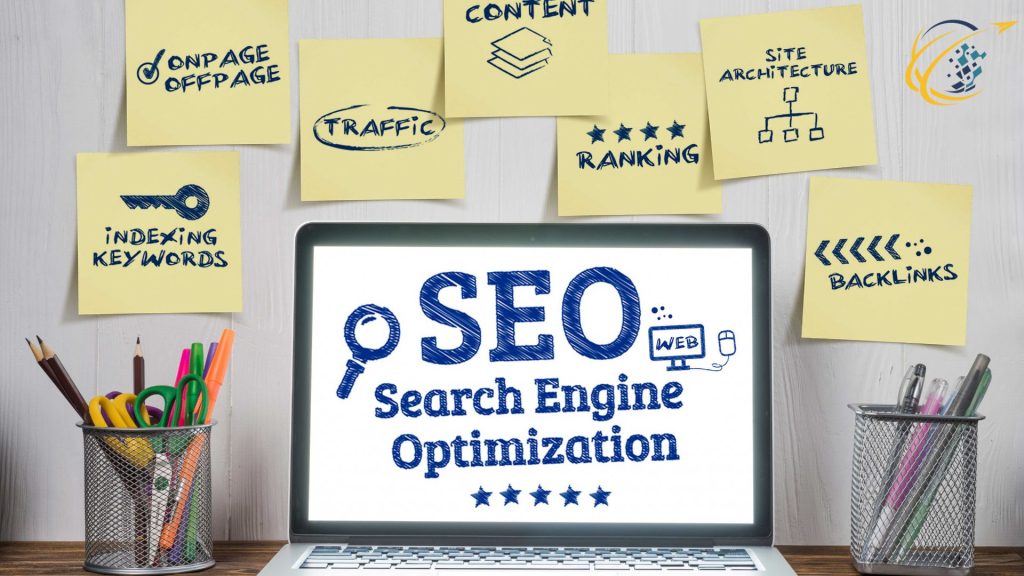Optimizing a business website for SEO is not just beneficial—it’s essential. Search Engine Optimization (SEO) serves as the backbone of online marketing strategies. It directly influencing a site’s ability to attract and retain users. However, the process of SEO encompasses much more than merely sprinkling keywords across web pages. It involves a detailed and strategic approach to website design, content creation, and user interaction. This is to ensure that the site not only reaches its target audience but also provides an engaging user experience. Below we’ll list the main aspects of SEO that are critical for enhancing a website’s performance. This ensures that businesses can effectively compete in the highly saturated digital market.
Keyword Research and Optimization
Keyword research and optimization form the cornerstone of effectively optimizing a business website for SEO. This process involves identifying the specific terms and phrases that potential customers are searching for. This directly relates to the business’ products or services. By integrating these relevant keywords into the website’s content, businesses can significantly improve their visibility in search engine results. Doing so attracts more targeted traffic.
Furthermore, keyword optimization is not just about increasing traffic; it’s about attracting the right kind of traffic. For instance, by targeting specific, relevant keywords, businesses can reach users who are more likely to convert into customers. Additionally, this targeted approach helps in ranking higher for specific searches. This will allow the website to outperform competitors who may not have a finely-tuned SEO strategy.
Moreover, the strategic placement of these keywords is equally important. They should be incorporated naturally into titles, headings, meta descriptions, and throughout the content body. This helps search engines understand the relevance of the content. It also ensures that the user experience is not compromised. Over-stuffing keywords, on the other hand, can lead to penalties from search engines, which may harm the website’s SEO performance.
Keyword research and optimization are vital for optimizing a business website for SEO. They provide a foundation for all subsequent SEO efforts, from content creation to on-page optimization. Therefore, businesses must invest the necessary time and resources to conduct thorough keyword research. This strategic focus is essential for enhancing online visibility and driving meaningful engagement with potential customers.
Improving Site Structure and Navigation
Improving site structure and navigation is a crucial aspect of optimizing a business website for SEO. A well-organized website facilitates a better user experience. It also enhances the ability of search engines to crawl and index the site effectively. This dual benefit significantly boosts the site’s visibility and ranking in search engine results.
Firstly, clear navigation makes it easier for visitors to find the information they are looking for without unnecessary clicks. This user-friendly approach reduces bounce rates and increases the duration of user sessions, which are positive signals to search engines. A logical structure with a clear hierarchy ensures that search engines can more discover all pages on the site. This aids in comprehensive indexing.
Using SEO-friendly URL structures and sensible categorization improves the clarity of the site both for users and search engines. Each page should be accessible through simple and intuitive paths. Additionally, implementing breadcrumb navigation and a robust internal linking strategy aids users in navigating the site. It also spreads page authority and ranking power throughout the site.
The structure and navigation of a website play pivotal roles in optimizing a business website for SEO. By ensuring that the website is easy to navigate and logically organized, businesses can help search engines better understand and prioritize their content, leading to improved search engine rankings. Furthermore, these improvements significantly enhance the overall user experience, encouraging visitors to engage more deeply and frequently with the site.
Optimizing On-Page Elements
Optimizing on-page elements is a fundamental strategy in enhancing a business website for SEO. Title tags, meta descriptions, headers, and images each play a specific role in improving a webpage’s visibility and attractiveness in search engine results.
Starting with title tags, they are the first element that search engines and users encounter. A well-crafted title tag should be concise, include relevant keywords, and accurately describe the page content. This not only helps search engines understand the page’s topic but also captures the user’s interest in search results, thereby increasing click-through rates.
Similarly, meta descriptions provide a brief summary of the webpage content. Although they do not directly influence rankings, compelling meta descriptions can significantly increase the likelihood of a user clicking on your result. They should be engaging, informative, and include targeted keywords that match search queries.
Headers, from H1 to H6 tags, organize content and help readers navigate articles more easily. For SEO, headers are essential for highlighting the structure of content and emphasizing key sections. Including relevant keywords in header tags, especially the H1, reinforces the page’s relevance to specific search queries, aiding in better search engine ranking.
Additionally, optimizing images by using relevant file names, alt text, and reducing file sizes can boost page load speeds, enhance accessibility, and provide additional content relevance signals to search engines. These optimizations are crucial for maintaining a competitive edge in SEO performance.
Optimizing on-page elements is critical in optimizing a business website for SEO. By carefully refining these elements, businesses can improve their SEO performance, attract more clicks from search results, and ultimately, drive higher engagement and conversions from their target audience. This attention to detail ensures that both search engines and users have a positive experience, crucial for sustained online success.
Content Quality and Blogging
Content quality and blogging are pivotal in optimizing a business website for SEO. High-quality, engaging, and original content not only attracts more traffic but also establishes the website as an authoritative source in its niche. This can lead to increased trust from users and search engines alike, which is essential for any successful SEO strategy.
Firstly, producing high-quality content means offering value that goes beyond the ordinary. This includes providing well-researched, insightful, and useful information that meets the needs and interests of the target audience. Such content naturally attracts visitors and encourages them to spend more time on the website, effectively reducing bounce rates. Moreover, engaging content is more likely to be shared across social media platforms, further increasing its reach and the number of inbound links, which are vital for SEO.
Additionally, regular blogging is an excellent way to keep the website fresh and relevant. Consistently updating the site with new, topical content can signal to search engines that the website is active, prompting more frequent indexing. This increased visibility can lead to better rankings and more opportunities to capture traffic from a variety of search queries.
Furthermore, the uniqueness of content plays a critical role in distinguishing a website from its competitors. Original content that is not found elsewhere can carve out a unique niche for the website, making it a go-to resource for specific information. This distinctiveness is highly rewarded by search engines and can lead to improved SEO rankings.
Focusing on content quality and blogging is essential for optimizing a business website for SEO. By committing to high standards of content production, businesses can drive more traffic, lower bounce rates, and significantly enhance their website’s authority. These efforts not only improve SEO performance but also build a loyal audience base, crucial for long-term success.
Mobile Optimization and Speed
Mobile optimization and speed are critical factors in optimizing a business website for SEO, especially given the increasing prevalence of mobile device usage for browsing the internet. Google’s mobile-first indexing further emphasizes the importance of ensuring websites are fully optimized for mobile users, as this directly influences how sites are ranked.
Firstly, a mobile-friendly website ensures that content is easily accessible and readable on smaller screens, with navigation tailored for touch interactions. This adaptability not only enhances the user experience but also positively impacts SEO rankings since Google prioritizes mobile-optimized sites in search results. Therefore, implementing responsive design, which automatically adjusts content layout based on the device, is essential.
Moreover, site speed is a significant factor in user retention. Mobile users often browse on the go and expect quick access to information. A slow-loading site can lead to higher bounce rates as users may quickly lose patience and exit the site. Additionally, Google incorporates page speed into its ranking algorithms, recognizing faster sites with higher search result placements.
To address these issues, techniques such as optimizing image sizes, minimizing code, leveraging browser caching, and using content delivery networks (CDNs) can be employed to improve load times. Each of these steps reduces the amount of data transferred and processed when a user visits the site, speeding up the overall experience.
In conclusion, mobile optimization and speed are foundational aspects of optimizing a business website for SEO. By ensuring that the site is responsive, loads quickly, and provides a seamless experience on mobile devices, businesses can significantly enhance their visibility in search engine results. This focus not only meets the technical requirements set by search engines but also aligns with the growing expectations of mobile users, crucial for driving engagement and conversions in today’s digital landscape.
Conclusion
In conclusion, optimizing a business website for SEO involves a comprehensive approach that addresses various critical elements. From conducting thorough keyword research to ensuring mobile optimization and quick load times, each aspect plays a vital role in enhancing the website’s visibility and performance in search engine rankings. By focusing on creating high-quality, engaging content and maintaining a strong structure and navigation, businesses can significantly improve their online presence. Furthermore, by adhering to best practices for on-page optimization and responding to the evolving preferences of users, especially in the mobile domain, companies can not only attract more traffic but also foster better engagement and conversions. Ultimately, a well-optimized website is not just about meeting SEO standards but about creating a seamless and enjoyable experience for users, which is the cornerstone of digital marketing success.



